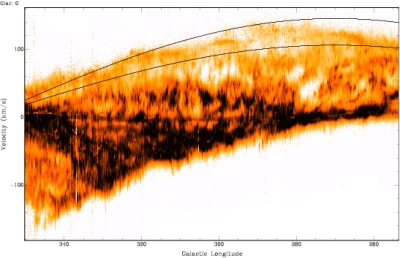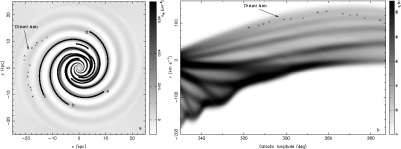A "new" spiral arm for the Milky Way?
|
N. M. McClure-Griffiths (ATNF); J. M. Dickey (University of Tasmania); B. M. Gaensler (Harvard University, USA) & A. J. Green (University of Sydney) The Southern Galactic Plane Survey (SGPS; McClure-Griffiths et al. 2001) is a survey for neutral hydrogen (HI) and 1.4 GHz radio continuum emission in the fourth quadrant of our Galaxy, using data taken with the Parkes radio telescope and the Compact Array. As part of the SGPS, a remarkable structure was identified in the far outer disk of the Southern Milky Way. The structure of the outer disk of the Milky Way has long been a mystery to Galactic astronomers. Though it is known that the HI disk extends far beyond the stellar disk, very little is known about its structure in this Galactic "outback". In particular, it is not known how far the HI spiral structure of the Galaxy extends. The new structure, shown near the top of Figure 1, is seen as a ridge of emission lying at the far positive velocity edge of the SGPS longitude-velocity (l-v) diagram. The l-v diagram shows HI emission in the mid-plane of our Galaxy (b = 0°). In this diagram, HI emission at negative velocities originates from gas that is interior to the solar circle and corresponds to gas at two distances, whereas HI emission at positive velocities occurs from gas that is exterior to the solar circle and generally corresponds to only one distance, with larger velocities at larger distances. The new ridge of emission arcs from l = 253°, v = 102 km s-1 through l = 299°, v = 110 km s-1 to l = 321°, v = 88 km s-1. It is relatively cohesive across more than 70 degrees on the sky and is notably the last feature before the edge of the Galactic disk. Overlaid on Figure 1 are lines of constant Galactocentric radius (Rg), the radial distance from the centre of the Galaxy), at 16 and 24 kiloparsecs (kpc). These two lines show that the feature extends from a radius of approximately 17 kpc at the low-longitude end to approximately 25 kpc at the high longitude end, with an estimated radial width of about two kpc. The feature extends to a significant distance out of the Galactic plane with a "scale height" that varies between 1.2 and 1.7 kpc. Within the feature, the average surface density is estimated to be 3 x 10-3 solar masses pc-2. The observed ridge in the longitude-velocity diagram could be caused by two different physical effects: a gas density enhancement or a significant velocity perturbation that causes gas at different distances to appear at the same velocity. A spiral arm produces a combination of these effects. Spiral arms typically produce only small HI density enhancements in the HI disk, but they also induce strong non-circular velocities, or streaming motions, where gas interior to an arm is pulled radially by the arm's gravity. Because the observed feature is not at a constant radius and appears to be radially confined, it might be a very distant spiral arm. To test this theory it is necessary to understand the shape of a spiral arm in l-v space. Figure 2 (left panel) shows a simple four-arm spiral model for the Milky Way with a "pitch angle", ie, that varies linearly from 16° at R = 4.25 kpc to 10° at R = 18 kpc. Using this spiral model and allowing for streaming motions around the spiral arms, synthetic HI spectra can be created and used to construct a synthetic l-v diagram as shown in the right panel of Figure 2. This model is by no means definitive, but it recreates many of the dominant features of the observed l-v diagram. In particular, the model l-v diagram also shows a narrow ridge of emission at the most positive velocities. Although the observed feature can be easily explained by a spiral arm, a number of other explanations were also considered such as whether the observed ridge might be due to elliptical gas orbits in the outer Galaxy, or to a very extended and smooth HI disk. However, none of these explanations were well-matched to the data and, on the basis of agreement with the spiral model, it was concluded that, the new feature in the outer Galaxy is best described as a spiral arm with a pitch angle of i ~ 9°. Another notable characteristic of this feature is that it shifts in velocity by about 10 km s-1 between longitudes of 275° and 295°, as seen in Figure 1. It is interesting that these longitudes agree well with the Galactic longitudes of the Large and Small Magellanic Clouds and the Leading Arm of the Magellanic Stream. In models of the orbits of the Magellanic Clouds, the Clouds cross the Galactic plane at a longitude of about 280°. It might be expected that the relative proximity of the Clouds would produce a significant dynamical effect on the outer Milky Way disk. Some models, such as Weinberg (1995), estimate that the orbit of the Large Magellanic Cloud should produce a radial shift in the HI at 18 kpc of about 10 km s-1. This may explain the observed velocity shift in the outer arm. There is still a great deal to understand about this most distant spiral arm in the Milky Way. For example, it remains to be seen whether there are any stars or star formation associated with the arm. Observations from the NANTEN telescope in Chile and follow-up observations with Mopra have revealed some 12CO emission at coincident positions in the low longitude end of the arm (Nakagawa et al., 2004). It is too early to say whether this gas might have formed stars. References: |
|


